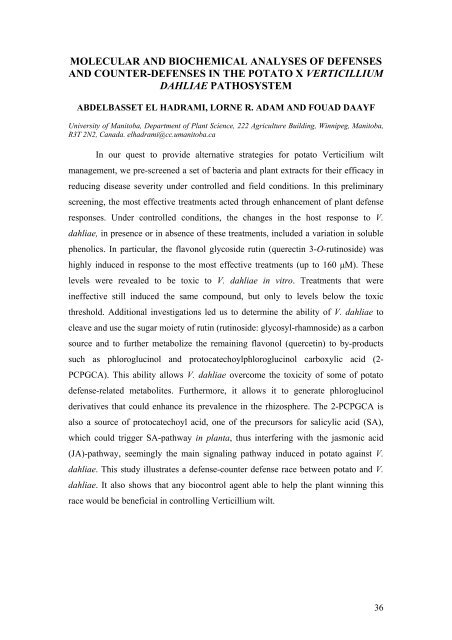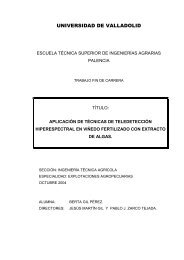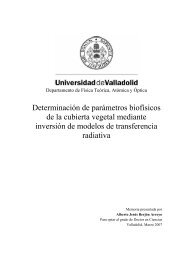10th INTERNATIONAL VERTICILLIUM SYMPOSIUM 16-20 ...
10th INTERNATIONAL VERTICILLIUM SYMPOSIUM 16-20 ...
10th INTERNATIONAL VERTICILLIUM SYMPOSIUM 16-20 ...
Create successful ePaper yourself
Turn your PDF publications into a flip-book with our unique Google optimized e-Paper software.
MOLECULAR AND BIOCHEMICAL ANALYSES OF DEFENSESAND COUNTER-DEFENSES IN THE POTATO X <strong>VERTICILLIUM</strong>DAHLIAE PATHOSYSTEMABDELBASSET EL HADRAMI, LORNE R. ADAM AND FOUAD DAAYFUniversity of Manitoba, Department of Plant Science, 222 Agriculture Building, Winnipeg, Manitoba,R3T 2N2, Canada. elhadrami@cc.umanitoba.caIn our quest to provide alternative strategies for potato Verticilium wiltmanagement, we pre-screened a set of bacteria and plant extracts for their efficacy inreducing disease severity under controlled and field conditions. In this preliminaryscreening, the most effective treatments acted through enhancement of plant defenseresponses. Under controlled conditions, the changes in the host response to V.dahliae, in presence or in absence of these treatments, included a variation in solublephenolics. In particular, the flavonol glycoside rutin (querectin 3-O-rutinoside) washighly induced in response to the most effective treatments (up to <strong>16</strong>0 μM). Theselevels were revealed to be toxic to V. dahliae in vitro. Treatments that wereineffective still induced the same compound, but only to levels below the toxicthreshold. Additional investigations led us to determine the ability of V. dahliae tocleave and use the sugar moiety of rutin (rutinoside: glycosyl-rhamnoside) as a carbonsource and to further metabolize the remaining flavonol (quercetin) to by-productssuch as phloroglucinol and protocatechoylphloroglucinol carboxylic acid (2-PCPGCA). This ability allows V. dahliae overcome the toxicity of some of potatodefense-related metabolites. Furthermore, it allows it to generate phloroglucinolderivatives that could enhance its prevalence in the rhizosphere. The 2-PCPGCA isalso a source of protocatechoyl acid, one of the precursors for salicylic acid (SA),which could trigger SA-pathway in planta, thus interfering with the jasmonic acid(JA)-pathway, seemingly the main signaling pathway induced in potato against V.dahliae. This study illustrates a defense-counter defense race between potato and V.dahliae. It also shows that any biocontrol agent able to help the plant winning thisrace would be beneficial in controlling Verticillium wilt.36




